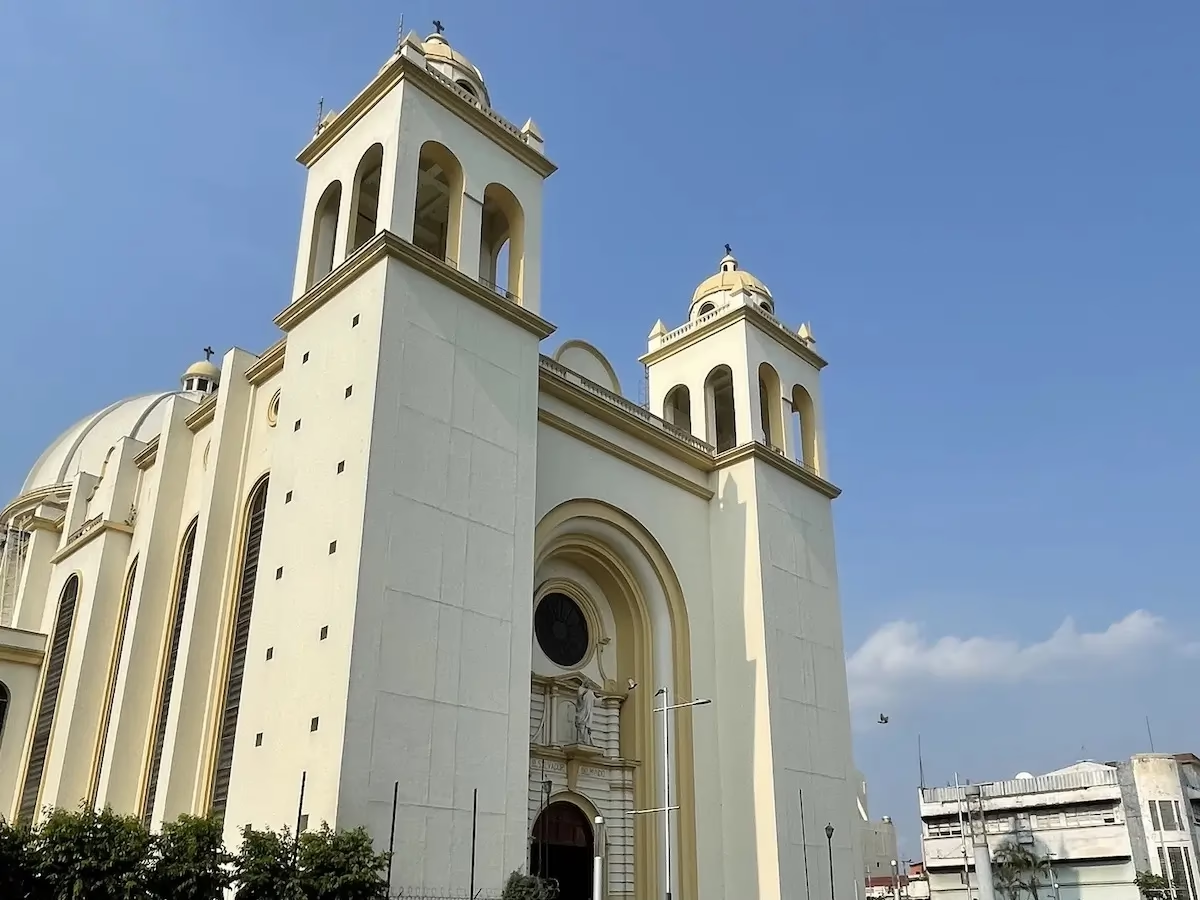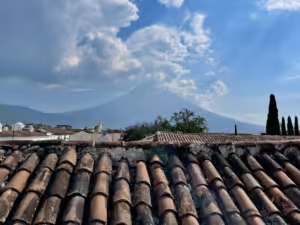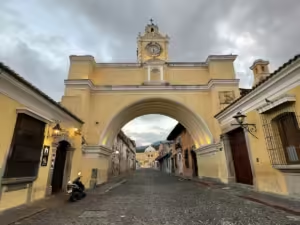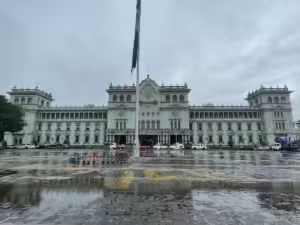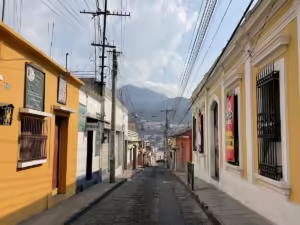There was a time not too long ago when the mere mention of El Salvador’s capital, San Salvador, struck fear into the hearts of all wholesome North American tourists. This city of two million still conjures up images of scary bald men with face tattoos toting guns and murdering with impunity. But in the last few years all that has changed.
Thanks to the controversial actions of Salvadoran president/”cool” dictator, Nayib Bukele, San Salvador is now one of the safest cities in Central America and ready to emerge as an exciting travel destination.
Travelers can now freely wander the streets and admire the city’s bizarre juxtaposition of gothic elegance and concrete brutalism or stroll through the parks and markets and soak in the friendly energy of a reemerging San Salvador. There are also, for some reason, a lot of mangos.
We only spent one night in San Salvador. I wish we would have stayed longer.
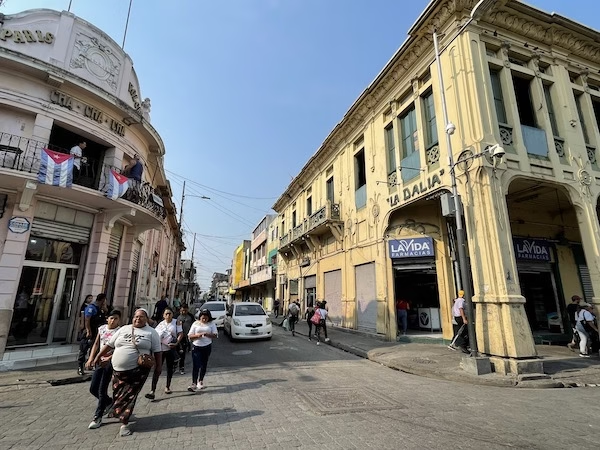
Safety in San Salvador and the Politics of “the World’s Coolest Dictator”
In 2015 San Salvador suffered the notoriety of having the highest homicide rate in the world. The murder rate has fallen since then, dropping drastically after Bukele issued a “state of exception” that allowed the government to suspend various constitutional and civil liberties. Police and military units arrested thousands. Over 1% of the population of El Salvador is now in prison.
There is evidence, however, that Bukele and his government have been cooking the books by changing how they count homicides. Even still, there’s no question that crime has fallen significantly. People can now walk around the streets of central San Salvador at night without fear. Nayib Bukele is by far the most popular politician in El Salvador, and maybe all of Latin America.
This new found safety has come at a cost. A number of groups have accused Bukele’s government of numerous human rights violations. The crackdown on gangs has also included a crackdown on journalists and others critical of Bukele’s regime. His second term is in and of itself a violation of El Salvador’s constitution. He even calls himself the “world’s coolest dictator.”
The situation in El Salvador brings up some very deep ethical questions about how a society balances safety and freedom. As you can probably tell, I’m very skeptical of Bukele. However, I also appreciate being able to walk around El Salvador safely. I can’t imagine how appreciative the locals feel, after suffering wave after wave of violence for years. But is it worth the backsliding on civil liberties and basic democratic rights? I don’t know, but I think these questions are worth thinking about as you enjoy wandering the streets of San Salvador.
I have some more thoughts about safety and crime in Central and South America. Read them here: Rethinking Travel Safety and Crime in Latin America
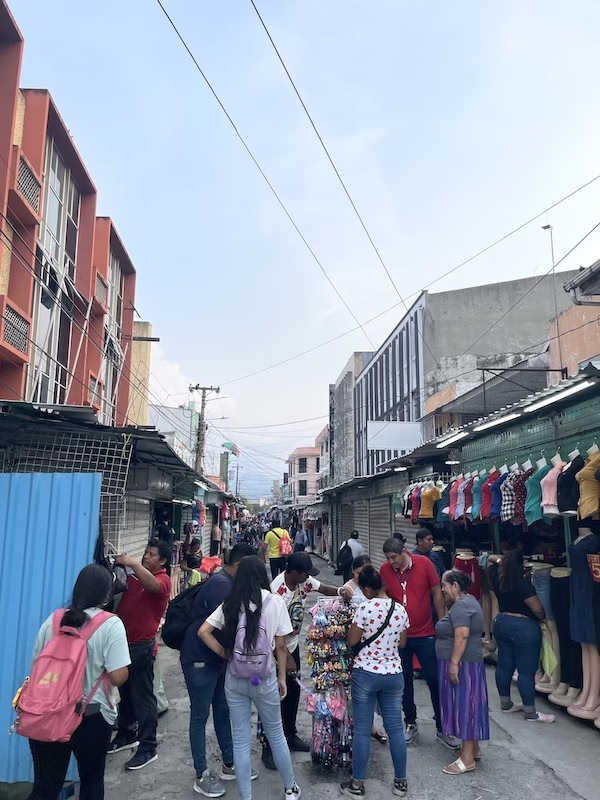
This is Not a Travel Guide to San Salvador
As I said before, we only spent one night in San Salvador. We had been thinking of skipping it entirely, which is what I think most tourists do, but instead decided to stop for a night on our way between La Ruta de las Flores and El Tunco. I’m glad we did.
However, since I only have one afternoon and an evening’s experience in the city, I don’t feel like I can write a guide like I would with some other destinations. Take a moment and forget about which sights to tick off your San Salvador bucket list. Instead, kick back, fix yourself a glass of fresh mango juice and read about our San Salvador travel experience.
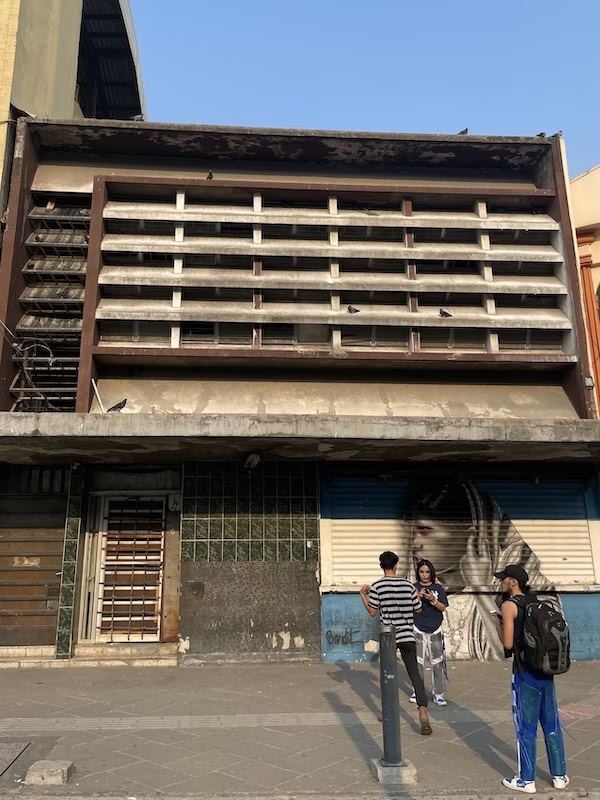
On one of the most fun, but also most stressful, aspects of travel is finding and booking places to stay. These days you have options ranging from dirt cheap hostel dorms to luxurious White Lotus style resorts. Thankfully, the internet is here to make finding accommodation easier.
Hostelworld is the go to app for finding hostels. For everything else, there’s Booking.com. If you book through either of the previous links, I’ll gain a small commission at no extra cost to you.
Wandering Around San Salvador’s Historic Center
Our hotel was at the end of a sleepy residential cul de sac, lined with rows of mango trees. The taxi driver got out to collect a few handfuls of the mangoes that had fallen onto the sidewalk and shove them into his trunk. We checked in and had a short rest.
Then it was time to hop in another taxi to explore San Salvador’s centro historico. Most of the colonial buildings from the Spanish era have been lost to earthquakes and other disasters. I found a solid handful of magnificent gothic and baroque looking structures to gawk at. San Salvador’s architectural landscape can be a bit jarring. The elegant old buildings sit next to more modern concrete brutalist structures that look like they might be the secret lair of some Cold War supervillain.
While I found the architecture interesting, and even some of the brutalist structures beautiful in their own way, I was struck more by the city’s energy. San Salvador’s center is lively and vibrant. Unlike the sleepy charm of Santa Ana, San Salvador feels more like it’s the place where things happen in El Salvador.
We wandered past a group aerobics class of some sort in one plaza. It reminded me of something you’d see in China. In another square, middle-aged couples were practicing what looked like ballroom dancing. Every public space was filled with people out and about, living their best lives.
All around the historic center we saw construction equipment and torn up pavement. As if San Salvador were literally rebuilding itself before our very eyes. A palpable sense of optimism filled the air, along with the dust and noise.
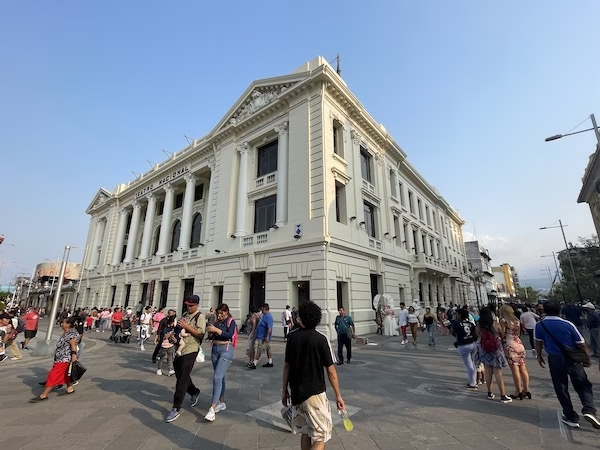
For those anxious control freaks who absolutely need to plan everything in advance: may I suggest Get Your Guide for booking tours? They’re generally cheaper than online alternatives and offer a wide range of activities. If you book through the following link, I’ll get a small commission at no cost to you and you’ll gain the satisfaction of supporting an independent travel blog. Click here to explore tours in El Salvador.
Nightfall and the Coming Storm
As the sun started to set, we found ourselves in front of an ornate church at the end of a blocked off street. People were mingling about and reporters were snapping photos. An orchestra was setting up on the cathedral steps. We stayed for a few songs, appreciating the unexpected wonder of stumbling on live classical music in the middle of El Salvador.
Finally, after a dinner of street pupusas, El Salvador’s national dish of stuffed tortillas, we decided to find a taxi and head back to the hotel. As we searched for a cab, we wandered down a street lined with gay bars. A group of guys tried to beckon us in to come join them. It probably would have been fun, but we were worn out.
Wandering around after dark felt completely safe. Only one person approached us, a man trying to sell us glow in the dark rosaries. I regret not buying one.
We finally found a cab, and just in time, too. Soon after we got back to the hotel, the wind shifted and some dark storm clouds rolled in. Rain turned into a torment as thunder and lightning crashed over downtown San Salvador. The windows rattled in the wind and the hotel lost electricity.
As we sat in the dark watching the storm, we noticed a woman at the house next door walking outside with a flashlight. She grabbed a ladder and climbed up onto the roof of her house. Was she looking for a lost cat? Was she trying to patch a leaky roof?
No. It turns out she was collecting mangoes that had blown off the trees in the storm. I don’t know why she couldn’t at least wait until the storm let up. She must’ve really liked mangoes.
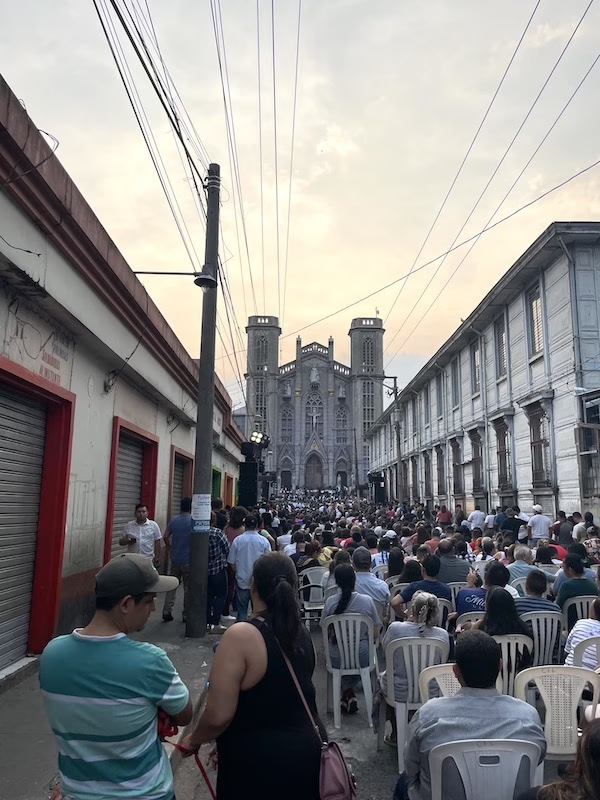
Where to Stay in San Salvador
We weathered the storm in a very modern hotel called Hotel Tazumal House. It was clean and sparkling new, although the roof did leak a bit during the storm. Thankfully, the owners seemed like they were on top of getting that fixed. My only real complaint was that it was a bit far from the center, but cabs were cheap and easy enough to get. If you book through this site, I’ll get a small commission at no cost to you.
Click here to book a room at Hotel Tazumal House
Final Thoughts on San Salvador
In the end, though the night ended dark and wet, I had a fantastic time in San Salvador. The city was well worth an afternoon spent wandering around aimlessly. And it was totally safe.
We didn’t end up doing anything the other travel blogs or guidebooks suggest. We just glanced at the Cathedral Metropolitana and the Iglesia El Rosario was closed. We didn’t go to any museums and skipped out on the Zona Rosa. I would definitely go back and do these things.
My only complaint about San Salvador is that the city isn’t very walkable outside of the historic center. The public transportation also felt lacking for a city of its size. Maybe that’s what some of the construction was about. I hope so.
Despite this, and despite my misgivings about Bukele’s harsh crime policies, I did really appreciate the new, optimistic mood that seems to be flowering in San Salvador. You can almost feel the hope permeating the air.
Also, the mangoes were pretty good, too.
Ready to explore more of the newly reinvigorated El Salvador? Exploring El Salvador: Central America’s Hidden Travel Gem is Ready to Shine
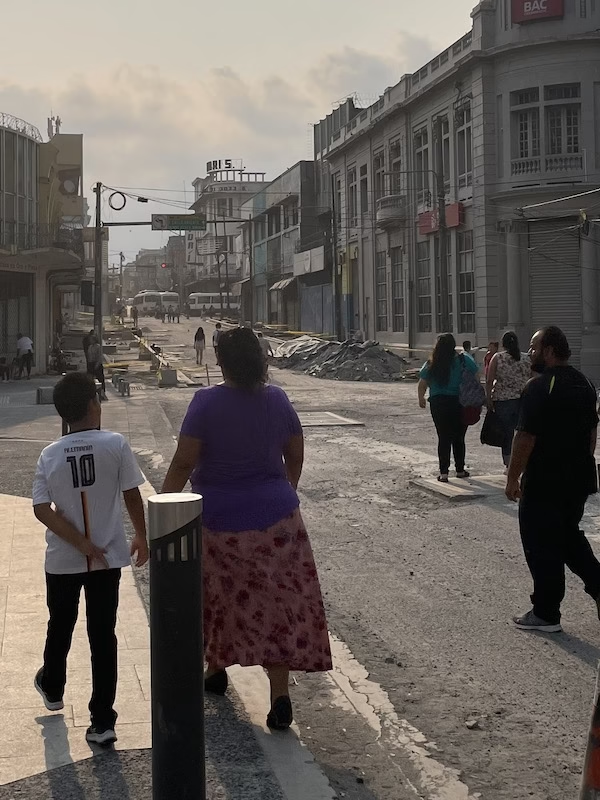
Useful Websites for Traveling El Salvador
As much as we might long for the days when you could show up to a town with nothing more than a beat-up guidebook and a sense of adventure, today much of traveling involves being glued to our phones making bookings. I’ve compiled some helpful apps and websites below that at least help make those bookings more convenient so you can spend less time staring at your phone and more time exploring at your surroundings. Some of these sites are affiliate links that give me a small commission at no cost to you if you chose to book through them. All of them are sites I’ve used personally and have no problem recommending.
Just be sure to do your due diligence as much as possible. Only hire local guides and try as much as possible to stay in locally owned hotels and hostels so that your hard earned travel dollars actually go to support the local economies of the places you visit.
Booking.com is basically the world’s only hotel booking website. They have hotels, guesthouses and vacation rentals all over El Salvador.
Hostelworld is the go-to site for booking hostels. If dorm rooms and shared bathrooms are your thing, you’ll find hostels all over El Salvador.
Get Your Guide offers tours and activities all around the world. Unlike some other sites and apps that do the same thing, you can actually find some reasonably priced deals here.
Centro Coasting is a great website to look up bus routes and times throughout Central America. Schedules change regularly, and the site is sometimes not as up to date as you’d like. However, it’s a good resource to help give you an idea when the buses leave, or at least get you to the right terminal.

